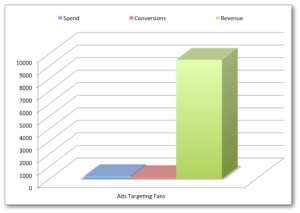
a man watching nothing on tv, but I’m sure he’s enjoying it
“Do sell and violence sell? A Meta-Analytic Review of the Effects of Sexual and Violent Media and Ad Content on Memory, Attitudes, and Buying Intentions” addresses the subject of sex and violence in media and ads, mostly speaking to those who assume that sex and violence sell. It begins with a joke, which I found refreshing, as I was about to delve into some really great statistics. It starts out by telling of the sex and violence in movies, TV, and video games. The researchers were interested if the use of sexual and violent media was justified. Robert Lull and Brad Bushman, authors of the article stated that “the simplest answer to this question is that advertisers think sex and violence sell, so they buy advertising time during sexual and violent programs, and in turn producers continue to create sexual and violent programs that attract advertising revenue.” Essentially, the TV networks work as delivery people for advertisers, sending consumers to them. Advertisers believe that sex and violence sell, which we will soon learn that there is some accuracy to that statement.
According to the article, half of media now contains violence, and a more than a quarter contains sex. This means that more exposure for the advertisers. According to the article as well, the age group most drawn to violent and sexual media is 18 to 34-year-olds, whose purchasing habits aren’t as set in stone as older adults, therefore the advertisers prefer to advertise towards that content. To put it simply, “violent and sexual media appeal to a key marketing demographic in addition to drawing large audiences.”
While larger events, such as the Super Bowl, do tend to accommodate larger audiences, and have more advertising, they do not necessarily cause higher buying intentions. Likewise, with the Olympics in 2002, advertising effectiveness actually decreased. It goes on to say, that while sexual and violent programs can have bigger audiences, it doesn’t necessarily mean that advertising effectiveness will increase.
“Studies across film, television, and video games suggest that advertising in violent or sexual programs and advertising with violent or sexual advertisements are both ineffective marketing strategies. Outcomes of these strategies include impaired memory for brands advertised during violent and/or sexual television programs, less favorable attitudes towards brands advertised in violent video games, and even declines in stock performance for brands placed in violent films.”

A graph showing the revenue brought in by ads.
This essentially boils down to violence impairs the memories of viewers.
They also wanted to delve into the buying intentions. There are eight steps in processing advertising: exposure, pay attention to it, comprehending, evaluating, encoding, retrieving, deciding, and buying or not buying. The second stage, paying attention, is possibly the most important because it directly correlates to advert effectiveness.
The study goes on to point out that the reason people enjoy violent and sexual media is because it relates to the primal notion of survival and reproduction. It is natural to relate to things that meet our primal standards.
“Based on evolutionary theory, we propose that people are hard-wired to pay attention to violent and sexual cues. Proponents of evolutionary theory argue that attention is selective because the mind evolved from an environment in which particular attention to potential threats to safety and potential opportunities for mating afforded survival and reproduction advantages. Our evolutionary ancestors that paid attention to violent cues were less likely to be killed by enemies or predators. Our evolutionary ancestors that paid attention to sexual cues were more likely to reproduce.”
This essentially means that those who took the cues were more likely to survive/reproduce.
To draw conclusions, there are a lot of effects on advertising. The way that sexual and violent medias are used are not necessarily effective, and can often blind consumers to the advertisements that they are seeing. This means that while sexual and violent media attract more attention, it doesn’t really help advertisers. Thusly, sexual and violent media is not useless, but rather redundant. This also correlated to the age of ads. As people have gotten used to sexual and violent ads or media, they become desensitized, thus making them forget the ads even more. Age, gender, and boundary conditions also affected buying memory as well. All in all, sexual and violent content in media does not necessarily serve as a viable helper for advertisers. It is a slippery slope trying to find the balance between good and bad.